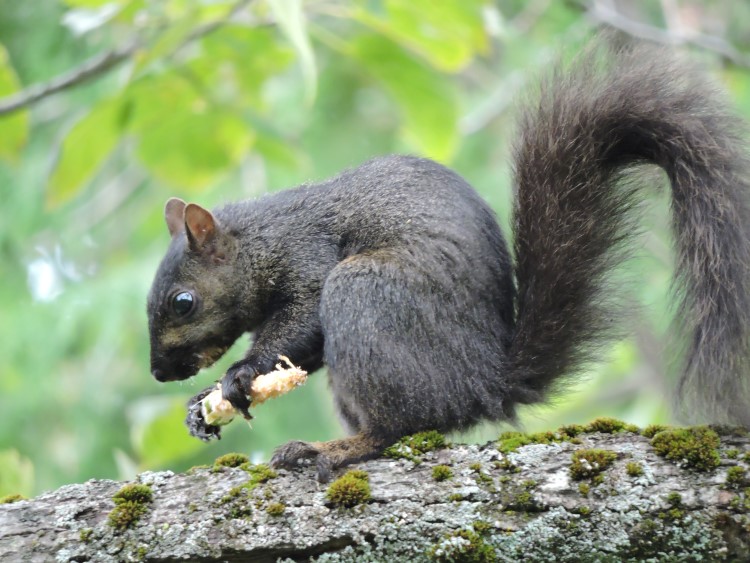
We are frequently entertained at the cottage watching the antics of our resident squirrels and chipmunks. Most people are familiar with these rodents as they are commonly seen throughout the daylight hours in both urban and rural settings. At the cottage we have eastern grey squirrels, American red squirrels and eastern chipmunks, all of which are members of the family Sciuridae. They are rodents, mammals whose upper and lower incisor teeth continue to grow throughout the animal’s life.
The largest is the eastern grey squirrel which can grow to a total length of 50 centimetres and weigh over 700 grams. There are two distinct colour forms: black all over; and, grey with a white belly. Sometimes both forms have cinnamon highlights. They have long bushy tails, which account for half of the animal’s total length, and that help with balance during their arboreal acrobatics. They den in trees, occupying abandoned woodpecker nests or natural tree cavities and when these are not available they build ‘dreys’ which are spherical dried leaf and twig nests high up in trees, nestled in the crotch of branches. They feed on a variety of nuts, seeds, fungi, fruits and bulbs. We often see them digging in the ground to store nuts and seeds, referred to as scatter hoarding, which ensures the cached food is unlikely to be all consumed by other animals. Coincidentally scatter hoarding aids in tree regeneration since some of those seeds and nuts are never dug up. Eastern grey squirrels remain active year-round. Typically they have one litter in the spring with two to four young. The following photos show a black form and a grey form of this species of squirrel.


American red squirrels are the next in size, growing to 35 centimetres in length and weighing up to 250 grams. Their back and tail are reddish-brown with a white underbelly, muzzle and eye rings. Their bushy tails make up almost half of their total length and are important in helping them balance while scurrying about and feeding in trees. Seeds, especially from conifers, form the bulk of their diet but they also eat flowers, berries, mushrooms, bird eggs and insects when available. At least one of our red squirrels supplements its diet by gnawing the baked-on residue off our barbeque grill after it has cooled. American red squirrel dens can include tree cavities, witches brooms (in conifers), hollow logs, wood piles and occasionally ground burrows. American red squirrels are very active all year. They usually have one litter in the spring comprised of four to five young. The following photo captures a rare, brief moment where a red squirrel is not in motion.

Eastern chipmunks are the smallest, growing up to 30 centimetres long and weighing 140 grams. As with all chipmunks, they have a striped back comprised of five dark stripes with four lighter stripes in-between; the two outer stripes are a cream colour and the two nearest the backbone are grey. The head and the rest of the back and tail are shades of brown and the underside is cream coloured. Their hair-covered tail accounts for one third of the animal’s overall length. Cartoonists got it right when illustrating the chipmunks ‘Chip and Dale’ as industriously scampering between their underground burrows and the surface to gather and store food. They have cheek pouches which they fill, when foraging, with berries, nuts, seeds and mushrooms. They then disgorge these into storage chambers that form part of their underground burrows. They consume this stored food throughout the winter during wakeful periods. More perishable foods, including insects, snails and slugs, are consumed as soon as they are caught and chipmunks have also been observed feeding on carrion. Chipmunks have one litter per year giving birth to three to five young in May.

Squirrels and chipmunks play an important role in spreading around nuts, seeds and berries. They, in turn, are an important food source for snakes, carnivores and some raptors. They are sometimes a source of entertainment or frustration for dogs visiting the cottage. Shiloh, the dog, spent hours sitting in this one position, starring at one squirrel that seemed to be taunting him.

Useful sources of information include Tamara Eder’s book Mammals of Ontario and Peter Alden’s Peterson First Guides – Mammals.

